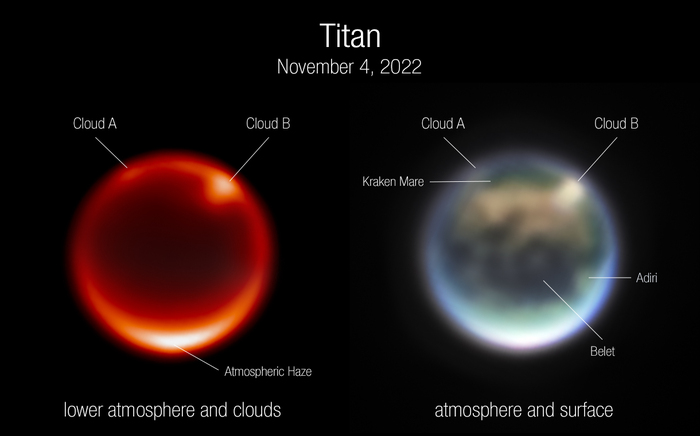The new James Webb Space Telescope has captured its first images of Saturn's largest moon, Titan, allowing it to trace the evolution of clouds in its atmosphere and obtain important clues on the seasonality of weather conditions, particularly useful in view of the Dragonfly exploration mission scheduled for 2027. The extraordinary infrared images, which allow details of Titan's lower atmosphere and surface to be seen, are published by NASA and the European Space Agency (ESA), which manage the telescope together with the Canadian counterpart CSA.
These first data collected, which have not yet been examined by the scientific community, have already aroused great euphoria among astronomers who have been waiting for them for years.
Titan is the only moon in the Solar System with a dense atmosphere, and it is also the only planetary body other than Earth that currently has rivers, lakes and seas, but made of hydrocarbons and not water.
Its atmosphere is filled with a thick haze that obscures visible light reflecting off the surface.
"Detecting the clouds is exciting because it validates computer model predictions of Titan's climate that clouds would readily form in the northern hemisphere during late summer when the surface is warmed by the sun," says Goddard's Conor Nixon. NASA Space Flight Center.
Nixon and his research team used the Webb telescope's NIRCam to observe Saturn's moon in the first week of November.
After spotting the clouds near Titan's largest sea of liquid methane (Kraken Mare), she immediately contacted colleagues at the Keck Observatory in Hawaii to ask for their support as well.
"We feared that the clouds would disappear when we watched Titan the next day with Keck, but to our delight there were clouds in the same positions on subsequent nights of observing, they seemed to have changed shape," says Imke de Pater, professor emeritus of astronomy at the University of California at Berkeley, leading the Keck Titan Observing Team.
The researchers also collected spectra with Webb's NIRSpec instrument, which is capable of detecting wavelengths otherwise inaccessible with ground-based telescopes.
These data, still being analyzed, will allow us to probe the composition of Titan's lower atmosphere and surface.
Further data from NIRCam and NIRSpec, as well as the first from the MIRI instrument, are expected by next summer.

